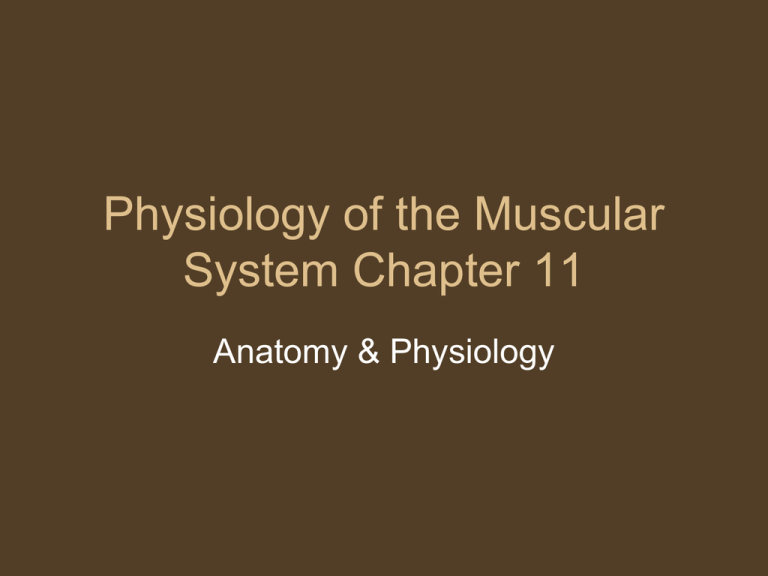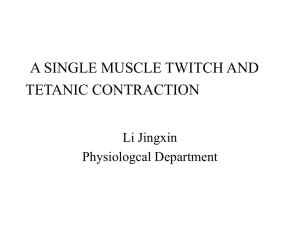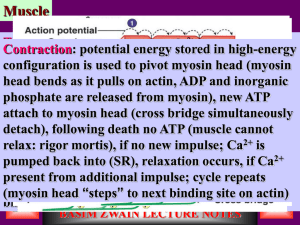Physiology of the Muscular System
advertisement

Physiology of the Muscular System Chapter 11 Anatomy & Physiology Functions • Movement • Heat production • Posture Typical cells Muscle cell=fiber Plasma membrane Sarcolemma Cytoplasm Sarcoplasm Endoplasmic reticulum Sarcoplasmic reticulum (SR) Many mitochondria Multiple nuclei Muscle cell structures not found in other cells • Myofibrils: bundles of very fine fibers • Thick and thin myofilaments: very fine fibers that make up myofibrils • Sarcomere: segment of myofibril between two Z lines; contractile unit • T tubules: run transversely across sarcoplasm at right angle to long axis of the cell; transmit electrical impulses thru cell Myofilaments • 4 protein molecules that make up myofilaments: Myosin, actin, tropomyosin, troponin • Thin filaments: actin, tropomyosin, troponin • Thick filaments: mostly myosin Contraction • Motor neuron: nerve cell that stimulates muscle cells • Neuromuscular junction: motor neuron connects to sarcolemma • This connection is a synapse in which there is a narrow gap across which the neurotransmitter, acetylcholine, is released Neuromuscular Junction Mechanism of contraction Motor neuron acetylcholine binds to receptors on sarcolemma impulse travels along sarcolemma thru T tubules to SR Ca released from SR binds to troponin exposing actin molecules in thin filaments myosin in thick filaments bind to actin and pull thin filaments to center of sarcomere Mechanism of Relaxation • Ca pumped back into SR shuts down the contraction troponin can again block actin’s active site Energy for Muscle Contractions • ATP: adenosine triphosphate • CP: creatine phosphate Glucose & Oxygen • Glucose stored in form of glycogen in muscle • Excess oxygen molecules in sarcoplasm bound to myoglobin Anaerobic respiration • Allows body to avoid use of oxygen in short term • Produces lactic acid • Accumulation of lactic acid in muscles causes burning sensation Motor unit • One motor neuron plus the muscle fibers it attaches to • The fewer the number of fibers supplied by one motor neuron the more precise the movements that can be produced. Myography • Force from the contraction of a muscle is recorded as a line that rises & falls as muscle contracts & relaxes • For a muscle to contract, an electrical stimulus of enough intensity (threshold stimulus) is applied to muscle Twitch contraction • Quick jerk of muscle • M. doesn’t contract at moment of stimulus • 3 phases: – Latent period – Contraction phase – Relaxation phase Treppe: Staircase Phenomenon • Gradual step like increase in strength of contractions that can be observed in a series of twitch contractions Tetanus • If a series of stimuli come in a rapid enough succession, muscle doesn’t have time to relax completely • Smooth, sustained contractions Tonic contraction (or muscle tone) • Continual partial contraction in a muscle • Important for maintaining posture • Flaccid: less tone than normal • Spastic: more tone than normal Isotonic contraction “equal tension” • Tone or tension within a muscle remains the same, length of muscle changes • The muscle shortens Isometric contraction “same length” • Muscle length remains the same while muscle tension increases • The muscle is unable to shorten Cardiac muscle • Striated involuntary • Cardiac m. fibers form strong electrically coupled junctions: intercalated discs • Branching of individual fibers • T tubules are larger than skeletal muscle Smooth muscle • Single nuclei, no T tubules • Calcium for contraction comes from outside the cell • 2 types: visceral & multiunit • Visceral: found in digestive, urinary, reproductive tracts in hollow organs • Multiunit: found in vessels, arrector pili









